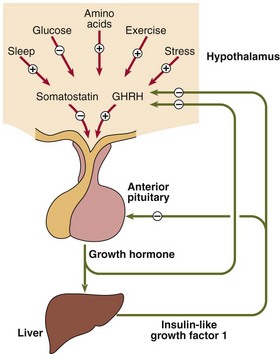Growth disorders and acromegaly
Normal growth
Growth in children can be divided into three stages (Fig 43.1). Rapid growth occurs during the first 2 years of life; the rate is influenced by conditions in utero, as well as the adequacy of nutrition in the postnatal period. The next stage is relatively steady growth for around 9 years and is controlled mainly by growth hormone (GH). If the pituitary does not produce sufficient growth hormone, the yearly growth rate during this period may be halved and the child will be of short stature. The growth spurt at puberty is caused by the effect of the sex hormones in addition to continuing GH secretion. The regulation of GH secretion is outlined in Figure 43.2.









